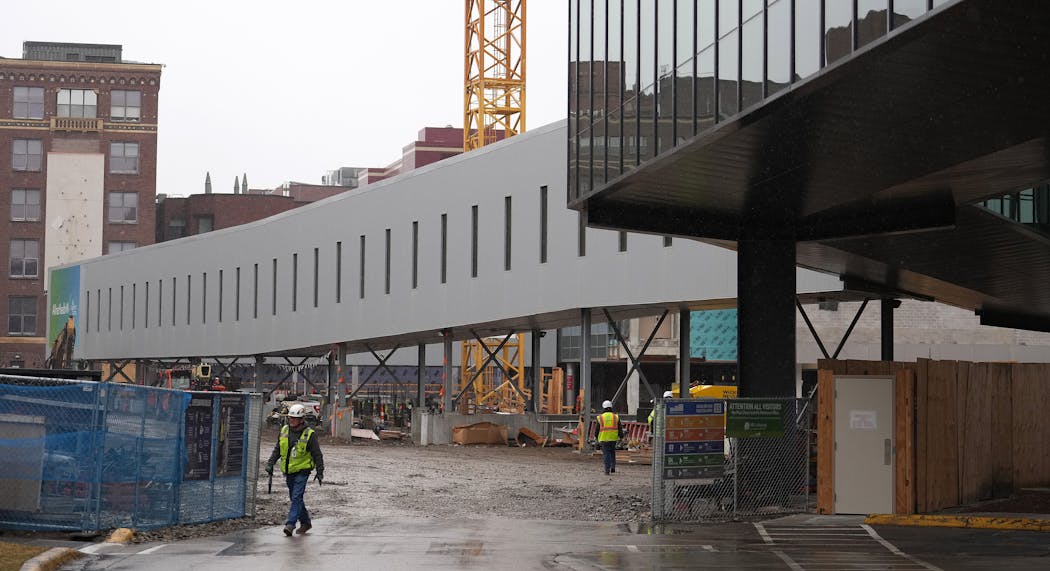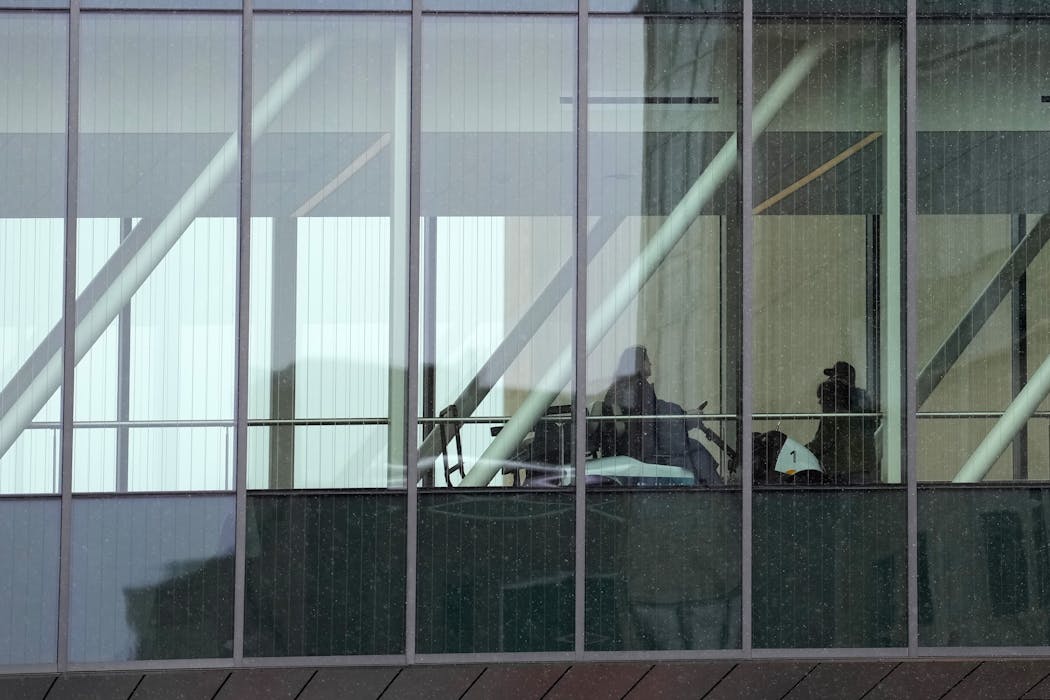Paul Saverinske knows a thing or two about skyways.
Five days a week, he drives a modified golf cart through one of the newest of these flying corridors in Minneapolis, shuttling patients between Abbott Northwestern Hospital and a massive parking garage south of the medical center.
At a length of 823 feet, this bridging skyway that opened last year is nearly the length of three football fields.
But is it the state's longest?
"This has gotta be one of them," Saverinske said.
There's no one source for data on all the skyways in Minnesota. These climate-controlled, elevated walkways — hallmarks of the state's largest cities and many health care campuses — include what are actually two different architectural features. There are those that pass through building interiors, and then there are flashier flyover bridges, which are suspended on pillars and adjacent structures.
The new skyway segment at Abbott Northwestern is a fancy flyover bridge. It's comprised of a permanent section, with end-to-end, floor-to-ceiling windows, and a temporary corridor with views of the worksite where Allina Health is building a new surgery and critical care facility.
"We believe this to be the largest we've built in Minnesota," said Mike Labukas, market executive at Mortenson, a Minneapolis-based builder and developer serving as general contractor.
"The length of this skyway was entirely defined by site conditions and re-routing staff/patient/material deliveries outside the patient tower construction site," Labukas said in an email. "It would likely never become an 'industry standard' to create skyways of this length."
But that doesn't mean it's not without peers in Minnesota.
Star Tribune reporting shows the state has more than a dozen skyway bridges that measure at least 300 feet long. There's a river-spanning segment in Rochester, a transit center freeway overpass in Eagan and a north-south corridor in the heart of St. Paul. While the survey was wide ranging, some candidates may have been overlooked.
Exactly how should you measure a Mayo Clinic structure that stands as the seven-layer dip of skyways, connecting two clinic buildings on seven different levels? We considered the cumulative length of all seven layers for ranking on the list.
In Duluth, a mighty skyway extends from the downtown business district all the way across Interstate 35 to the Duluth Entertainment Convention Center. While it includes a support structure that once provided stairway access to street level, functionally, we deemed this to be one rather than two conjoined skyways.
Jennifer Yoos, an architecture professor at the University of Minnesota, said she's eager to find out the identity of the state's longest skyway bridge, as she's uncertain of the answer.
In 2016, Yoos published a book detailing how skyways have been a recurrent concept in urban planning and design since the 19th century. They are most remarkable when skyways are part of large networks that create a distinct layer teeming with urban life, she said. Yet the longest segments often function more like spurs.
"I think the long bridges are really fascinating, because they're not so much a part of a network — they're kind of an extension of it," Yoos said. "In some cases, it seems to be more about parking."
Start asking questions about skyways in Minneapolis, and Michael McLaughlin's name quickly surfaces. About 20 years ago, while working for the Downtown Council, McLaughlin was staff administrator for a city-appointed group called the Skyway Advisory Committee, now defunct.
At about 9.5 miles in total length, the city's skyway network is regarded, at least by Wikipedia, as one of the two largest in North America. Calgary's network spans 9.9 miles, although not all segments are contiguous as they are in the Minneapolis. McLaughlin says his data suggests the Minneapolis system actually is bigger, stretching for more than 11 miles.
While acknowledging it's not very Minnesotan of him to say, McLaughlin believes his skywayaccess.com website has the very best map of the Minneapolis skyway system. He uses it in his consulting work with business owners, making sure designated skyway paths are open for crowds walking to large events at Target Center and U.S. Bank stadium.
Complete with GIS coordinates, McLaughlin's map shows 101 distinct skyway bridges in the Minneapolis system. About half of them measure between 50 and 100 feet. One of the shortest stretches just 15 feet between the Lumber Exchange and Midtown Garage.
The longest stretches between the hulking A and B parking ramps at the west edge of downtown, a corridor that measures 705 feet when you include two spurs to Target Center, McLaughlin said.
If you don't include the spurs, the longest bridge in downtown Minneapolis stretches 560 feet across Washington Avenue before passing beneath the overhang at 100 Washington Square and traveling out to a retail building adjacent to Churchill Apartments. This segment is the closest the downtown skyway network gets to the Mississippi River.
"I have walked every segment of the skyway that exists and those that had existed — and even those that are no longer open to the public," McLaughlin said. "Throughout the history of skyways in Minneapolis, building owners have done the math and determined that being connected to the system was more valuable than not being connected."
Considering McLaughlin's data, the Abbott Northwestern skyway is the longest in Minneapolis, but what about statewide?
In Rochester, city officials say their skyway crossing the Zumbro River measures an impressive 445 feet. But the Star Tribune awards the southern regional crown for longest skyway to Mayo Clinic, with its seven-layer skyway spanning W. Center St. Each layer measures nearly 90 feet for a cumulative 629 feet of skyway between the Gonda and Charlton buildings.
Yet that's not as much skyway as the bridge to the Duluth Entertainment Convention Center (DECC).
The Star Tribune adopted McLaughlin's measurement convention that allows a support structure to be included, putting the DECC skyway length at 651 feet.
"In the late '70s and early '80s, I believe the skywalk ran 917 feet without running through a building," said Phil McLoughlin, the Duluth convention center's director of building services. Portions have since been incorporated in other structures.
The Star Tribune award for the state's longest bridge goes to Minneapolis-St. Paul International Airport and its bridge connecting the C and G concourses, where moving walkways help air travelers trek its 977-foot length.
Rankings are fluid, of course. The skyway at Abbott Northwestern will get shorter as the construction project moves to completion over the next two years. Starting in 2025, the pedestrian path is scheduled to be re-routed to a temporary corridor within the new hospital building, at which point the temporary portion of the skyway will be dismantled.
When the new building opens in 2026, the permanent skyway will measure 448 feet.
For now, the fastest way through the corridor is on Paul Saverinske's golf cart, although he's careful not to drive too quickly. The best part of the job, he said, is meeting people and talking with them during the 60 or so round trips he makes each day.
They can talk about things like: Boy, this skyway is pretty long, isn't it?
"That just passes the time for the three minutes that it basically takes to get down there," Saverinske said. "Because I figure they want a little chit-chat — a little conversation."




